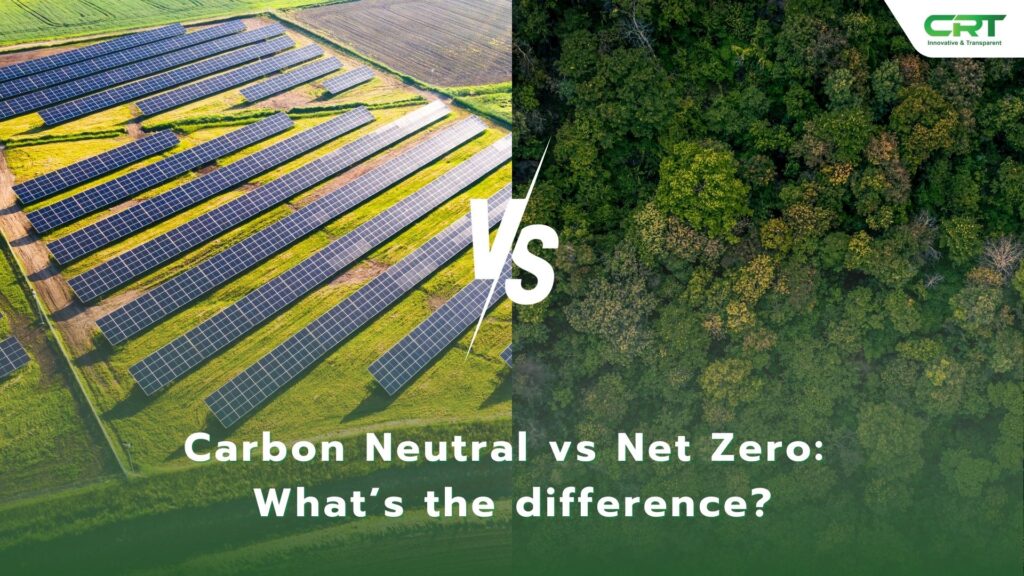As the world grapples with the urgent challenge of climate change, two terms have become increasingly prevalent in discussions about environmental sustainability: We often hear the terms “Carbon Neutral” and “Net Zero Emissions”, especially in the context of environmentally friendly business practices. However, these two terms, although similar, have distinct differences in their details. So, what is the difference?
Definition of Carbon Neutral vs Net Zero
Carbon neutral refers to carrying out any activity or process without causing a net increase in greenhouse gas emissions into the atmosphere. This can be achieved by reducing emissions or offsetting them by removing or absorbing an equivalent amount of greenhouse gases.
Net Zero Emissions means having no net greenhouse gas emissions into the atmosphere, even if some emissions occur, as long as they are completely offset.
Example of offsets
Carbon Neutral would be an automotive company reducing carbon dioxide emissions from its factories by improving production efficiency and offsetting the remaining emissions by planting forests that absorb carbon dioxide.
Another example is a coal mine that reduces methane emissions from mining operations by capturing the gas for energy production and planting forests to absorb the carbon released.
Net Zero Emissions include a solar power plant that produces electricity without any greenhouse gas emissions during operation, or an industrial plant that still has some emissions but uses technologies and methods to absorb greenhouse gases in an amount equal to or greater than what is released.

Scope
Scope Greenhouse Gas refers to a categorization system used to classify greenhouse gas (GHG) emissions based on their source. It divides emissions into three main categories:
- Scope 1: Direct Emissions Greenhouse gas emissions that occur directly from sources owned or controlled by the organization, such as fuel combustion, industrial processes, fugitive emissions, etc.
- Scope 2: Indirect Emissions Greenhouse gas emissions that result from the generation of electricity, heat, or steam purchased from external sources.
- Scope 3: Other Indirect Emissions Greenhouse gas emissions that occur from sources not owned or directly controlled by the organization but are related to its activities, such as upstream and downstream supply chain emissions, employee commuting, waste disposal, etc.
Reporting emissions across all three scopes allows organizations to account for and manage their overall greenhouse gas footprint comprehensively. Scope 1 covers direct emissions, Scope 2 covers indirect emissions from purchased energy, and Scope 3 includes all other indirect emissions associated with the organization’s operations and value chain.

Standard and certification
- Greenhouse Gas Protocol (GHG Protocol): This widely used accounting standard helps organizations calculate and report their greenhouse gas emissions across all three scopes.
- ISO 14064 and ISO 14067: The International Organization for Standardization (ISO) has developed standards for quantifying, monitoring, reporting, and verifying greenhouse gas emissions. ISO 14064 guides organizations to quantify and report their emissions, while ISO 14067 focuses on the carbon footprint of products and services.
- Science-Based Targets Initiative (SBTi): The SBTi is a joint initiative between several organizations, including the CDP (formerly the Carbon Disclosure Project), the United Nations Global Compact, the World Resources Institute (WRI), and the World Wide Fund for Nature (WWF). It provides a framework for companies to set science-based emissions reduction targets that align with the goals of the Paris Agreement to limit global warming to well below 2°C above pre-industrial levels and pursue efforts to limit it to 1.5°C.
- PAS 2060: This is a specific framework for achieving carbon neutrality. It outlines requirements for measuring, reducing, and offsetting CO2 emissions to become carbon neutral.
Challenges in Achieving Net Zero
- Measuring and tracking emissions accurately: Accurately measuring and tracking greenhouse gas emissions across all scopes (Scope 1, 2, and 3) is a complex task, especially for large organizations with extensive supply chains and operations. Developing robust measurement methodologies and data collection systems can be challenging and resource-intensive.
- Financial Hurdles: Transitioning to low-carbon or carbon-free energy sources, and implementing energy efficiency measures. It may require significant investments in new technologies, infrastructure, and process changes.
- Policy and regulatory uncertainty: Inconsistent or rapidly changing policy and regulatory environments can create uncertainty for organizations, making it difficult to plan and implement long-term strategies for emissions reductions and net-zero initiatives.
- Stakeholder engagement and collaboration: Achieving net-zero emissions often requires coordination and collaboration among various stakeholders, including suppliers, customers, policymakers, and local communities. Aligning interests, establishing shared goals, and fostering cooperation can be challenging.
Reference:
MIM-Carbon-Neutrality-in-Real-Estate-Strategies-for-Success.pdf (metlife.com)
Corporate-Value-Chain-Accounting-Reporing-Standard_041613_2.pdf (ghgprotocol.org)
Carbon Neutral คืออะไร รู้จักคำนี้เบื้องต้นจาก ดร.การดี เลียวไพโรจน์ (springnews.co.th)

